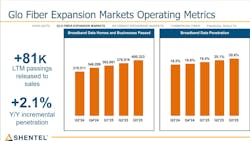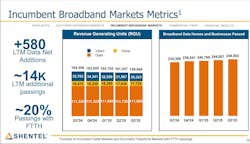Shentel’s CEO says it is on track to complete its fiber broadband build by the end of 2026
Key Highlights
- Shentel aims to complete most of its fiber build by the end of 2026, with a focus on expanding Glo Fiber in greenfield and rural markets.
- During Q3, Glo Fiber passings increased by 81,000 to over 400,000, with revenue growth driven by customer additions and higher-speed plans.
- The company reported a 39.5% YoY growth in Glo Fiber data RGUs, reaching approximately 83,000 customers, and a 37% increase in total Glo Fiber RGUs.
- Shentel's broadband penetration in expansion markets reached 20.6%, with early cohorts achieving an average penetration of 37%.
- Strategic promotional plans and higher speed tiers helped maintain strong ARPU and customer growth despite industry seasonality and competitive pressures.
Shentel is bullish about the prospects of its fiber builds, signaling that it will have most of its fiber broadband build complete by the end of next year.
The service provider continued to expand the reach of Glo Fiber, a trend that continued into the third quarter.
During the third quarter, Shentel passed an additional 21,000 homes, reaching a total of 400,000 total Glo Fiber passings homes and businesses in its greenfield expansion markets.
Glo Fiber data revenue-generating units grew to 83,000 at the end of the quarter, representing year-over-year growth of 39.5% and Glo Fiber revenues grew 41.1%, reaching $21.3 million.
Speaking to investors during its third-quarter earnings call, Ed McKay, the new CEO of Shentel, said that completing its network expansion “remains a top priority.”
“We remain on track to substantially complete our build by the end of 2026,” he said, adding that “we’re focused on driving penetration rates in Glo Fiber markets and expanding our commercial fiber business.”
Competitive differentiation
Given the dynamics of the broadband markets it serves, Shentel is in a unique competitive position.
As it continues to expand fiber broadband, McKay noted that “our markets have compelling competitive dynamics that differentiate us from our broadband peers.”
A large majority (92%) of Shentel’s Glo Fiber passings are duopoly markets with only one wireline broadband competitor. Likewise, in Shentel’s incumbent markets, 70% of its passings have no wireline broadband competitor.
Shentel continued to find success in achieving new growth in its Glo Fiber expansion markets. During the third quarter, the telco added 6,400 new customers and about 7,200 total data, video and voice revenue-generating units (RGUs).
McKay said that “600 of the new customer additions were from our recent Blacksburg, Virginia acquisition that we closed and integrated in July.”
The service provider also continued to grow its data RGUs and broadband penetration of Glo Fiber passings.
Over the last 12 months, Shentel added over 23,000 data RGUs across the Glo Fiber expansion markets to end the third quarter with approximately 83,000 Glo Fiber customers, up 39% year-over-year. Total Glo Fiber revenue-generating units reached more than 97,000 at the end of the quarter, up 37% from the same period a year ago.
Glo Fiber passings exceeded 400,000 at the end of the third quarter, up 81,000 year-over-year. Broadband data penetration in its Glo Fiber expansion markets climbed 2.1 percentage points to 20.6% at the end of the third quarter.
“Growth in our Glo Fiber expansion markets has followed a consistent, predictable pattern with steady increases in data penetration rates as cohorts mature,” McKay said. “We typically achieve 15% data penetration rates within the first year and 25% by year 3.”
He added that “Our earliest cohorts, which launched in 2019 and 2020, have now reached an average data penetration rate of 37%.”
Overcoming broadband seasonality
While the third quarter typically is a time when the broadband industry sees the highest levels of churn due to greater move churn, especially around schools and universities, it appeared not to influence Shentel’s third-quarter broadband results.
McKay said “broadband data average revenue per user remained strong in the third quarter at roughly $77, supported by customer adoption of higher speed tiers.”
One factor that helped Shentel in the third quarter was a new promotional rate plans that offer enhanced speeds with a 5-year price guarantee. This promotion was in response to Comcast’s move to launch a 5-year price guarantee in Shentel’s markets in June.
McKay said that while Comcast’s promotion had a slight impact on Shentel’s gross addition side, it did not drive additional customer churn, and more of its new customers are choosing higher-speed gigabit service plans.
“As a result of our new plan, we saw an increase in subscriber gross additions in the second half of the quarter, with 68% of our new residential customers choosing speeds of 1 Gbps or higher, including 12% choosing speeds of 2 Gbps and 3% choosing speeds of 5 Gbps,” McKay said.
Enhancing incumbent fiber penetration
While Shentel continues to ramp up its Glo Fiber base in Greenfield markets, it is also growing out its fiber footprint in its legacy rural markets.
It saw a small increase in overall broadband subscribers. In all, Shentel had 112,000 rural broadband data customers, reflecting a year-over-year increase of 580.
However, Shentel’s data, voice and video RGUs were 160,000 at the end of the third quarter, down 3% year-over-year, primarily due to video customers moving to online streaming options.
The service provider also increased rural fiber penetration. As of the end of the third quarter, Shentel passed 248,000 homes and businesses with broadband, up about 14,000 over the same period a year ago.
“This increase was driven by the construction of new government-subsidized passings in previously unserved areas,” McKay said. “As a result, approximately 20% of our incumbent broadband passings are now equipped with fiber-to-the-home technology.”
Keep up to date with Lightwave’s earnings coverage.
You can check our publication’s key segments:
And
And for more on Shentel, check out these articles:
Shentel's CEO: Residential Glo Fiber and commercial fiber to surpass incumbent revenues next year
Glo Fiber drives revenue mix
Fiber was a key driver in Shentel’s overall revenue growth during the third quarter.
Driven by another quarter of strong Glo Fiber expansion market revenue growth of $6.2 million or 41.1%, revenue grew 2.5% to $89.8 million.
However, the Glo Fiber revenue growth was partially offset by declines in Shentel’s other lines of business. Incumbent broadband markets' revenue declined $1.6 million, mainly due to a 15% decline in video RGUs due to customers switching to streaming video services.
Having invested $212 million in capital expenditures year-to-date, Shentel built 1,700 route miles of fiber in the last year and has completed construction on 89% of the planned 22,000 government-subsidized unserved passings in its incumbent markets.
Jim Volk, CFO of Shentel, said that “we expect to complete this construction in mid-2026, and this will be a driver of lower capital intensity in future years.”
Looking forward, Shentel has set a goal to achieve positive free cash flow. “Before our heavy investment cycle in Glo Fiber expansion markets, Shentel consistently delivered positive free cash flow,” McKay said. “Returning to that position is a key milestone, and we remain on track to reach positive free cash flow for the full year 2027, driven by declining capital intensity and continued customer growth.”
To achieve its cash flow goal, it plans to refinance its credit facilities through a hybrid structure, asset-backed securitization for its Glo Fiber and commercial fiber businesses, paired with a new credit facility for its incumbent broadband business in the coming months.
“We expect this approach to lower our cost of debt, strengthen our credit profile and increase financial flexibility,” McKay said. “These improvements will position us to capitalize on opportunities in a consolidating industry and deliver greater value to our investors.”
For related articles, visit the Business Topic Center.
For more information on high-speed transmission systems and suppliers, visit the Lightwave Buyer’s Guide.
To stay abreast of fiber network deployments, subscribe to Lightwave’s Service Providers and Datacom/Data Center newsletters.
About the Author
Sean Buckley
Sean is responsible for establishing and executing the editorial strategy of Lightwave across its website, email newsletters, events, and other information products.




